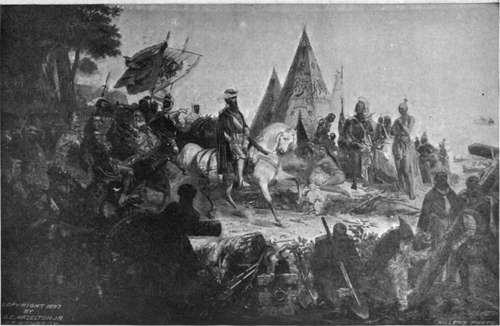Garfield
Description
This section is from the book "The National Capitol. Its Architecture Art And History", by George C. Hazelton, Jr. Also available from Amazon: The National Capitol Its Architecture Art and History.
Garfield
Late in the afternoon of September 21, 1881, the plateau to the east of the Capitol was massed with military organizations. The officers of the army and navy were drawn up in two lines leading to the foot of the grand central steps, which were crowded with people save where a passageway had been kept open to the bronze doors. The grounds were crowded with spectators, but all was as still a? night. Before the steps was a hearse drawn by six magnificent gray horses. A rich casket was dislodged and borne slowly up the steps, accompanied by the reception committee, President Arthur and members of the Cabinet, and by legislators and justices of the highest court of the government. The Marine Hand played its saddest dirge. The casket was placed tenderly on the bier, and a second martyred President slept in the rotunda of the Capitol. For a moment the assemblage stood in silence. Then the panel was removed, and the familiar face, emaciated with long suffering, lay open to view. But where were the eloquent lips trembling with the emotion of fiery debate, where the full cheek, where the intellectual brow, where the bright eyes whose last intelligent gaze had been upon the boundless sea at Elberon ? Even General Grant, whose duty it had been to gaze carelessly on death, was affected by the scene. A guard of honor was left to watch the casket.

THE DISCOVERY OF THE MISSISSIPPI.
On the morning of the 22d, the public were permitted to pay their tribute, and during that day thousands passed in at the eastern door and out at the western, some even ascending the dome to see the great number of mournful citizens in the rotunda and the long line outside the Capitol, stretching to Second Street and Pennsylvania Avenue, each awaiting his turn to pass the casket. It is supposed that 40,000 persons so paid their tribute. The rotunda was draped in mourning. Exquisite floral decorations surrounded the bier. One massive wreath attracted the greatest attention. It came from the British Embassy at the express command of the Queen. On a card were the words : " Queen Victoria, to the memory of the late President Garfield. An expression of her sorrow and sympathy with Mrs. Garfield and the American nation. September 22, 1881." At half-past six in the evening, by order of Secretary Blaine, supposedly at Mrs. Garfield's request, the late President's face was closed to view. Even this did not stay the interest of the public; during the next morning, thousands passed the closed casket.
On the morning of the 23d, Mrs. Garfield, accompanied by her daughter Mollie, her son Harry, Colonel and Mrs. Rockwell, General Swaim and Attorney-General and Mrs. MacVeagh, drove to the Senate wing and repaired to the President's room. Sergeant-at-Arms Bright was imme'diately summoned; and at Mrs. Garfield's request, the guard retired from the rotunda, and all its entrances were closed. At half-past eleven, the bereaved widow passed through the north door and knelt by the mortal remains of the President. The walls of the rotunda only can tell of that farewell !
At noon, by Mrs. Garfield's request, General Swaim and Colonel Rockwell, the devoted friends and faithful nurses of the departed, closed and locked for the last time the casket-lid. That afternoon, services were held in the presence of a most distinguished gathering. The veterans of the Army of the Cumberland were the first to enter the rotunda. The officers of the army and navy wore crape upon their sleeves and sword hilts. The Chief Justice and Associate Justices Miller, Harlan and Matthews were present, wearing their official robes. From the south wing came the members and officers of the House. From the north wing came the Senate, accompanied by the Cabinet and ex-Vice-Presidents Hamlin and Wheeler. In advance were ex-Presidents Grant and Hayes, with President Arthur on the arm of Secretary Blaine. The last two sat at the west end of the semi-circle directly opposite the ex-Presidents. Seats in the front row were reserved for the Cabinet also and for members of the family. The officiating clergymen and the philharmonic societies were grouped about the head of the casket. As the first notes of the hymn " Asleep in Jesus " were sung, the guard of honor quietly withdrew, leaving the body to the offices of the Church. Scripture was read by Rev. Dr. Rankin. This was followed by the prayer of Elder Isaac Errett of Cincinnati. Rev. F. D. Poweres, of Vermont Avenue Christian Church, of which Garfield was a member, then preached the funeral sermon, after which another prayer was offered by Rev. J. G. Butler. As the casket was borne down the steps of the Capitol, a beautiful rainbow was clearly visible against the dark, cloud-swept sky. What did it portend ?
Continue to:
- prev: Stevens
- Table of Contents
- next: Logan
